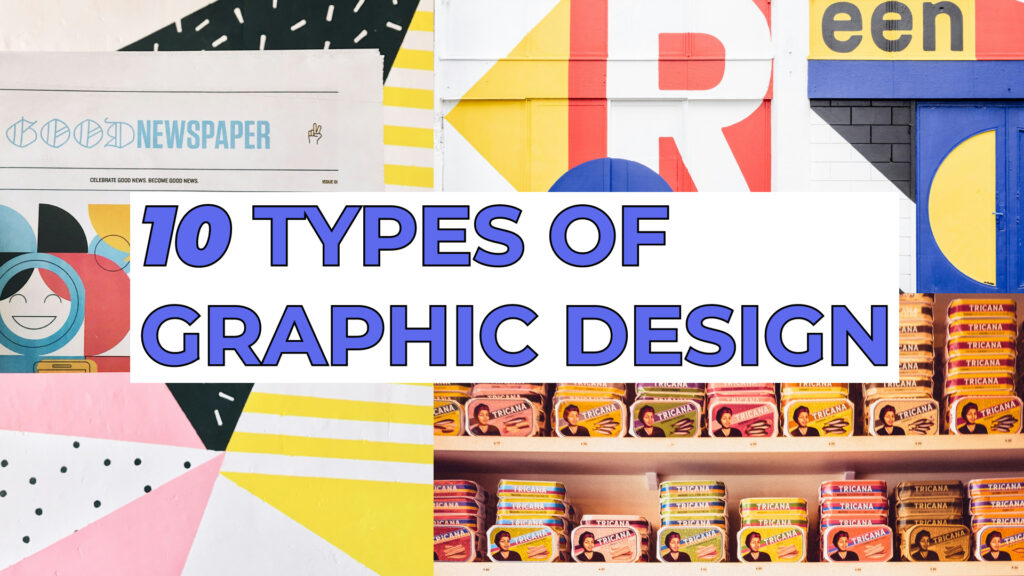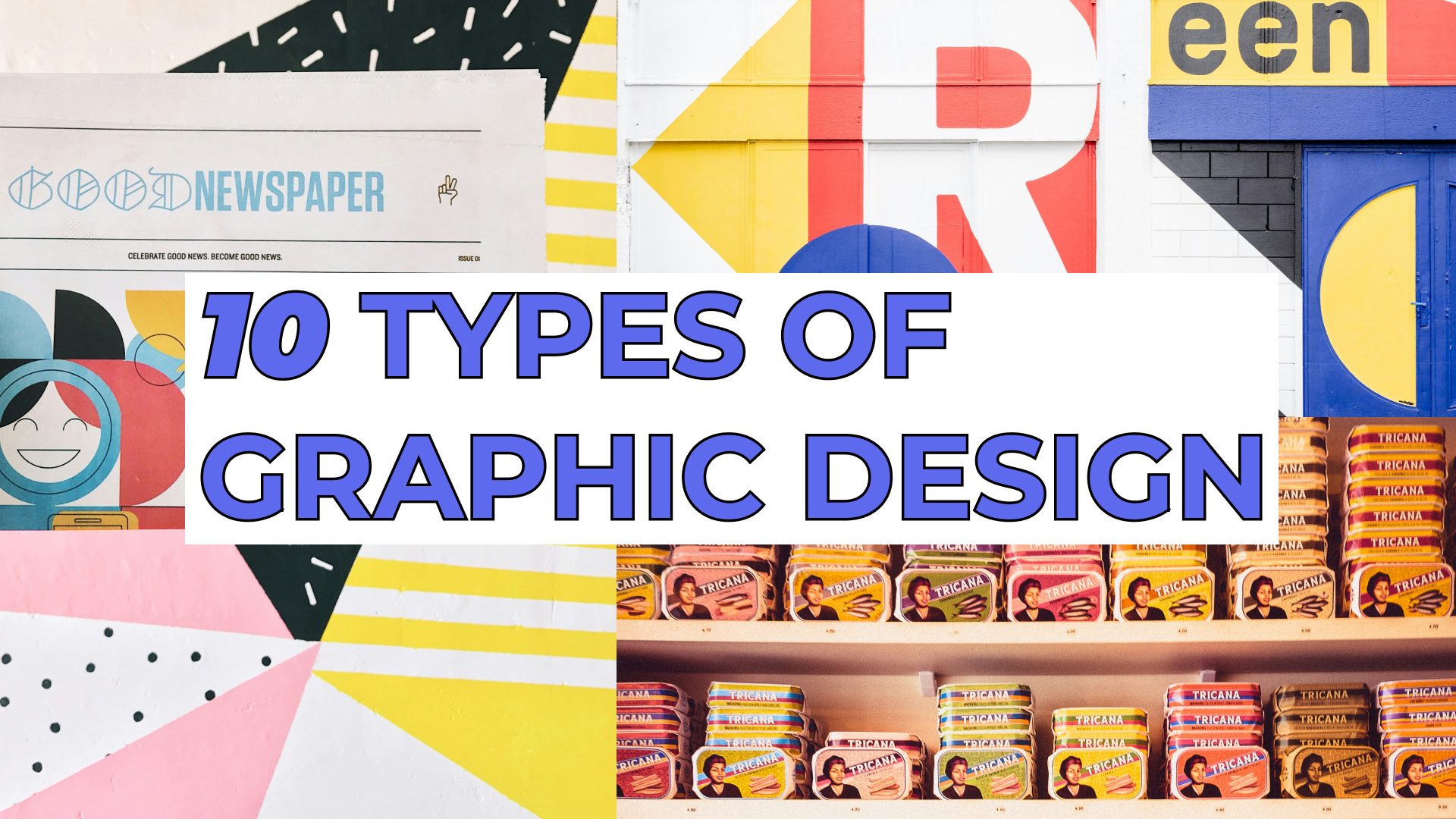I’m sure you’ve heard of graphic design here and there. What is it exactly, though? Well, it is a lot of things. Graphic design is your favorite cookie package, a bestseller book cover, a video game you can’t stop playing, and a catchy billboard you pass on your way to work.
Graphic design is the art and practice of planning. It projects ideas and experiences through visual and textual content. And whether you realize it or not, it shapes nearly every aspect of our daily lives. There are numerous types of graphic design. From the logo on your coffee cup and the layout of this very article to not buying terrible products because of confusing packaging! It helps us understand things, feel things, and sometimes even buy things we probably don’t need (oops).
Table of contents:
10 Types of graphic design
1. Packaging Design
The cookie package I’ve mentioned above had to catch your attention before it got a chance to become your favorite, right? And having a well-crafted packaging design is undoubtedly the way. See, everybody has at least once bought something because… it looked pretty! Or have you ever used a lovely wine bottle as a candle holder? Well, I certainly have.
The best packaging designers balance form (that “ooh, pretty!” factor), structure (will it actually protect what’s inside?), materials (cardboard? plastic? something sustainable?), and visual communication (does it scream “BUY ME!” in the right way?). The best packaging isn’t just good-looking, it’s practical too. It has to protect the product, be easy to open, and reflect the brand’s vibe.

2. Publication and Typographic Design
Do you judge a book by its cover? I mean, would you rather buy the one with terrible illustration and font, or the one pleasing to the eye and easy to read? Tough call, I know. That’s what typography deals with. It arranges type to make written language readable and appealing. You can learn more about the process in our article on creating a comic book.
Books, magazines, newspapers, and digital publications all rely on graphic design to organize information. Publication designers are the unsung heroes who transform walls of text into engaging reading experiences.
Publication designers are masters of layout. They use grid systems to create visual harmony and make content easy to consume. Next time you pick up a magazine that feels effortless to read, thank a publication designer who spent hours over line spacing and margins.
Tools like Approval Studio have revolutionized how these publication designers collaborate and perfect their work. Our online proofing platform streamlines the often chaotic feedback process. This allows designers to collect, track, and implement comments on everything from book covers to magazine spreads. With features like version comparison and precise annotation tools, Approval Studio removes the headache of emails and ensures everyone is literally on the same page.
3. Brand Design
This is where a company’s whole vibe comes to life. A brand identity includes logos (the face of the brand), color palettes (its mood), typography (its voice), and imagery style (its body language). They all work together to build a visual identity that people recognize and (ideally) trust. The brand design creates the visual personality of a company. It’s like giving a business its own fashion sense and making sure it never leaves the house in mismatched socks (unless it’s on purpose).
Logo design sits at the center of this universe. A great logo is simple enough to be memorable but distinctive enough to stand out. Take, for example, Nike’s swoosh. It’s so simple a child could draw it, yet loaded with meaning and instantly recognizable worldwide. A strong brand design makes you feel like “Yeah, I know these guys.”

4. Advertising and Marketing Design
If brand design is a company’s personality, advertising design is its pickup line. It needs to be memorable and persuasive enough to get your attention in seconds.
Advertising designers are masters of visual storytelling under constraints. They have to deal with billboards you’re driving by at 70mph, magazine ads competing with actual content, and digital ads that need to work across multiple screen sizes.
Print advertising requires immediate visual impact to grab attention. Digital advertising needs interactivity, animation, and customization. Both require a deep understanding of human psychology. Print ads still have their place, but digital is prior now. And these are carousels on Instagram, banner ads, and email campaigns that make you click. Hopefully, the ad itself and not the hide ad button…

5. Environmental Graphic Design
Environmental graphic design helps people find their way around places using visual elements. If the last time you’ve been to a hospital you found your way to the right department without a breakdown – send prayers for the environmental designer! Without them, we’d all still be wandering around trying to find the bathroom at the mall. They design those wayfinding systems that help us navigate complex spaces like airports, museums, and… supermarkets! No, seriously – designing supermarkets is a complex art. Sometimes, they may be designed to be disorienting on purpose! Why do you think they don’t usually have windows?
Beyond pure functionality, it can transform spaces through murals, architectural graphics, and exhibitions. Environmental designers can create a whole story-telling experience. Graffiti is viewed as an act of vandalism, mostly. However, it can also be totally Instagrammable when done right.

6. Web Design
Web design involves creating functional, accessible, and aesthetic websites. Recalling digital ads, web designers need to consider how their creations will behave across different screen sizes. Key aspects include:
- Responsive design (making websites look good on everything from your massive desktop to your tiny phone)
- Navigation and information (organizing content so users can find what they need)
- Visual hierarchy (guiding the user’s eye to what’s most important)
- Loading speed (because we all have the patience of a hungry toddler)
Today’s web designers work closely with UX and UI to create sites that both look good and function properly. At its core, web design is what makes a website look good and actually work. And we have come a really long way to make web designs like that
7. UI and Interactive Design
Web design is about creating digital spaces. And UI design focuses on the controls and touchpoints within those spaces. These are the buttons, menus, and interactive elements users engage with. It’s about making digital experiences feel intuitive and enjoyable.
UI designers create digital experiences by focusing on how users interact with screens and interfaces. If it’s not much of a hassle to find the “like” button, fill in the forms, or change the language, then the UI design is well done.
User research and testing are crucial to UI design. So designers create prototypes and watch real users interact with them. Then they refine them based on actual behavior rather than guesses.
Another crucial element of UI is accessibility. It ensures digital products work for everyone, including people with disabilities. Features like high contrast modes, screen reader compatibility, and keyboard navigation alternatives are ethical go-tos.

8. Motion Graphics and Animation
Motion graphics bring static design elements to life through animation. You’ll find them in title sequences, social media posts, and even corporate presentations (where they try hard not to be boring).
Motion designers apply animation to create movements that feel natural and engaging. Ever noticed how app icons bounce slightly when you tap them? That tiny animation provides visual feedback and makes interfaces feel responsive. The best motion design enhances rather than distracts. Bet loading bars make you feel much better than just the word itself.
Tools range from traditional frame-by-frame animation to professional software like Adobe After Effects. The key principles remain the same: timing, pacing, and purpose.
9. Game Design
Visual game design works with crafting characters, environments, and objects. The aim is to create cohesive, immersive worlds. Minecraft’s blocks, Silent Hill’s fog, Mario Kart’s tracks – you name it – game artists create visual languages that define entire universes.
Talking details, designers create interfaces that provide information without pulling players out of the gameplay. The health bars, maps, and inventory screens need to be both functional and visually integrated with the game world. The best game design strikes a balance between visual appeal and gameplay mechanics. A beautiful game that’s frustrating to play won’t keep users for long. Similarly, an addictive game with poor visuals might not attract players in the first place.

10. Illustration
Illustration sits between fine art and commercial graphic design. Commercial illustrators create images that tell stories, explain concepts, or play with our emotions. Unlike fine artists who create for self-expression, commercial illustrators solve visual communication problems. Modern illustration includes:
- Editorial illustrations for articles and publications
- Character designs for brands and products
- Infographics that make data easy to read
- Decorative elements that add personality to designs
Digital tools have revolutionized illustration. It allowed artists to mimic traditional ways while taking advantage of digital ones. Take layers and those precious undo buttons.
Key skills required for graphic designers today
Even though there are so many different types of graphic designers, the basics always remain the same. Here are some bullet aspects of graphic design that stand at the core:
- Technical skills are usually the first that comes to mind. Industry-standard software like Adobe Creative Suite is non-negotiable. But don’t get too comfortable – new tools appear constantly, and adaptability matters more than mastery of any single program.
- Typography and layout knowledge separate professionals from amateurs. Understanding how to create visual hierarchies and reading patterns makes the difference. It parts designs that communicate effectively from those that just look pretty.
- Color theory isn’t just about picking nice palettes. Color psychology and different cultures’ interpretations help make strategic choices that support communication goals.
- Project management and organization skills keep you employed. Meeting deadlines, organizing files, and managing resources are as important as creative abilities. The most brilliant designer who can’t deliver on time won’t keep clients for long.

- Client communication and presentation skills might be the most underrated design skills. Explaining concepts, presenting work, and receiving client feedback are essential for success.
- Adaptability and continuous learning keep designers relevant in rapidly changing design fields. What worked five years ago might be outdated today. Graphic design requires constant skill development and trend awareness.
- Marketing and psychology basics help designers create work that doesn’t just please the eye but also motivates action. Understanding how people perceive and respond to visuals makes design more effective.
- Portfolio development and self-promotion ensure your brilliant work gets seen. In a crowded marketplace, the ability to showcase your work can be as important as the work itself.
Conclusion
No matter how many areas of graphic design are there, the truth is that it’s a huge part of our routine. It influences how we perceive the world, make decisions, and navigate our environments. It’s equal parts art and strategy, creativity and problem-solving, expression and communication.
And with so many different kinds of graphic design out there, there’s something for every creative brain. It doesn’t matter if you’re into bold branding, intuitive web pages, or epic game worlds. There’s a safe haven for everybody.
Now go forth and design something awesome! Or, you know, just appreciate the next cool coffee label you see.

 TEAM SOLUTIONS
TEAM SOLUTIONS WORKFLOW SOLUTIONS
WORKFLOW SOLUTIONS



 REVIEW TOOL
REVIEW TOOL PROJECT MANAGEMENT
PROJECT MANAGEMENT TOOLS & INTEGRATIONS
TOOLS & INTEGRATIONS
 CLIENT INTERVIEWS
CLIENT INTERVIEWS









